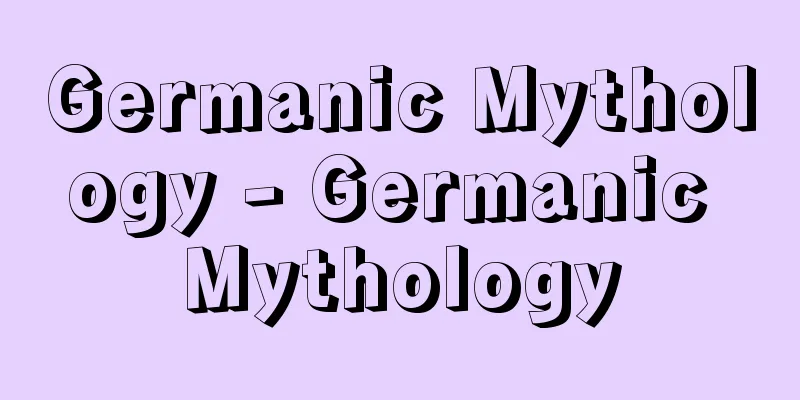The Tale of Genji

|
A long fictional story written by Murasaki Shikibu in the early 11th century, during the mid-Heian period. Its correct title is "The Tale of Genji," but it is also called "The Tale of Hikaru Genji," "The Tale of Murasaki," or "Murasaki no Yukari." In later generations, it was abbreviated to "Genji," "Gengo," "Murasaki Bun," and "Murasaki Shi." It covers the life of the protagonist Hikaru Genji and the various lives of his family over a period of over 70 years, and depicts in detail and with elegance the inner workings of the lives of the court nobility at the height of imperial culture. Its outstanding literary achievement, completely different from previous narrative works, can be considered a miracle in the history of literature. It is revered as a classic that has continued to have normative significance not only in the history of narrative literature but also in the development of Japanese cultural history, and is not only a legacy for the Japanese people, but is also recognized worldwide as one of the greatest works of literature. [Ken Akiyama] Number of volumes and circumstances of its creationThe extant version of The Tale of Genji consists of the following 54 volumes: 1. Kiritsubo, 2. Hahakigi, 3. Utsusemi, 4. Yugao, 5. Wakamurasaki, 6. Suetsumuhana, 7. Momiji no ga, 8. Hana no en, 9. Aoi, 10. Sakaki, 11. Hana chirusato, 12. Suma, 13. Akashi, 14. Miotsukushi, 15. Yomogi, 16. Sekiya, 17. Eawase, 18. Matsukaze, 19. Usugumo, 20. Morning glory, 21. Otome, 22. Tamakazura, 23. Hatsune 24 Butterfly 25 Firefly 26 Everlasting Summer 27 Bonfire 28 Storm 29 Imperial Visit 30 Wisteria Hakama 31 Wooden Pillar 32 Plum Branch 33 Wisteria Leaves 34 Young Leaves (Upper) 35 Young Leaves (Lower) 36 Oak Tree 37 Flute 38 Bell Cricket 39 Evening Mist 40 Imperial Law 41 Vision 42 Palace of Fragrant 43 Red Plum 44 Bamboo River 45 Bridge Princess 46 Shiimoto 47 Agemaki (agemaki) 48 Sawarabi (sawarabi) 49 Yadorigi (mistletoe) 50 Azumaya (arbor) 51 Ukifune (ukifune) 52 Kagero (kagerō) 53 Tenarai (tenarai) 54 Yumenoukihashi (floating bridge of dreams) [Ken Akiyama] SynopsisBased on its theme and structure, The Tale of Genji can be considered a trilogy consisting of Part 1 (from 1 "Kiritsubo" to 33 "Fuji no Uraba"), Part 2 (from 34 "Wakana no Ue" to 41 "Maboroshi"), and Part 3 (from 42 "Nioumiya" to 54 "Yume no Ukihashi"). [Ken Akiyama] Part 1: "Kiritsubo" - "Fujiuraha"The first part begins before the birth of the protagonist, Hikaru Genji. In the harem of a certain emperor, the daughter of the late Grand Minister, Kiritsubo no Koi, without any guardianship to support her, separated the many empresses and monopolized the emperor's love, eventually giving birth to a second prince blessed with unparalleled beauty and talent. However, the concubine became the target of hatred and jealousy from her peers, and when the prince was three years old, she died of an illness caused by the stress. The concubine's surviving child grew up under the protection of the emperor, and showed divine talent in all areas of learning and the arts. The emperor made the prince the crown prince, and hoped to eventually abdicate the throne, but he gave up as he found it difficult to gain support from those around him, and instead became a commoner and was given the surname Minamoto. The crown prince was the first son of the Minister of the Right, Suzaku-in, born to the daughter of the Emperor's younger sister, Kokiden no Nyogo. Genji came of age at the age of 12 and married Lady Aoi, the daughter of the Minister of the Left, whose mother was the Emperor's younger sister. He was promised a secure social status, but after the death of his mother, Kiritsubo no Koi, he fell in love with the former Emperor's fourth princess, who had been taken in by Fujitsubo of the Imperial harem and become his father's beloved wife. Driven by an uncontrollable passion, he had an affair with her, and as a result, Fujitsubo became pregnant. The two shared a sin that must never be made known. Forbidden to approach Fujitsubo again, Genji suffered from a thirst for love, and this is the beginning of his endless journey with women. He discovered Fujitsubo's niece, Lady Murasaki, in the Kitayama Mountains and forcibly took her to live in his own home, Nijo-in, because he wanted to see Fujitsubo in her. Fujitsubo eventually gave birth to a son, Reizei-in, and the emperor, unaware of the secret, rejoiced at the birth of a prince who was the spitting image of Genji. When Genji was 20 years old, the Emperor abdicated to Suzaku-in, and Reizei-in became the Crown Prince. However, during Suzaku-in's reign, the power of Genji and the Left Minister inevitably declined, in stark contrast to the prosperity of his mother, Empress Kokiden, and the family of the Right Minister. The shadow of misfortune also crept into Genji's life. After his wife, Lady Aoi, gave birth to their first son, Yugiri, she was possessed by a persistent demon and died. The demon was the living spirit of Lady Rokujo, who had been humiliated by a carriage fight with Lady Aoi and her entourage on the day of purification at the Saiin Temple of Kamo. The Lady was the wife of the now deceased former Crown Prince, and had been sending Genji on a secret mission, but after this incident she gave up her relationship with Genji and left Kyoto with her daughter, who was serving as Saigū (Saigū) at Ise. Thus, dark clouds began to gather around Genji, and especially after the death of Tonobu-in, who was 23 years old, he was gradually driven into a difficult situation by the tyranny of the Minister of the Right. Under these circumstances, the relationship between Genji and Oborozukiyo, who was the favorite of Suzaku-in as a Naishi no Kami, was revealed. Oborozukiyo was the daughter of the Minister of the Right and the younger sister of Kōkiden, and had been in a secret relationship with Genji even before he entered the Imperial Court. Kōkiden and the Minister of the Right were furious and plotted to frame Genji as a traitor and eliminate him from the political world. In the spring of his 26th year, Genji left Kyoto and retired to Suma, where he lived in seclusion, but a year later, he was caught in a storm and the ghost of his father, the emperor, appeared to him in a dream. Following his father's instructions, he moved to the residence of Akashi no Nyudo, who lived on the coast of Akashi. He eventually married the daughter of the Nyudo, Akashi no Kimi, and gave birth to Akashi no Himegimi. After two years of wandering, Genji was summoned back to the capital, and soon after, Suzaku-in was replaced by Reizei-in, who, together with the Left Minister who had returned to the political world, set out on the road to prosperity. However, at this stage, Genji gradually came into conflict with the Left Minister's family. He subjugated Lady Aoi's older brother, Tonochujo, who had once been his best ally, and established unrivaled power. When Genji was 32 years old, Fujitsubo passed away, and Reizei-in, who learned the secret of his birth through a secret message from a monk in the night residence, tried to abdicate the throne to his father, Genji, but Genji reneged on this intention, and eventually rose from the position of Daijo-daijin to the position of Jun-daijyo-tennō, built an earthly paradise called Rokujō-in, and reached the height of his prosperity. The above is an outline of Part 1, which tells the story of Genji up to the age of 39. During this time, the story includes not only the life of Fujitsubo, who, despite being the emperor's consort, protected Reizei-in while suffering the sins that she shared with Genji, but also his dubious negotiations with Utsusemi, Yugao, and Suetsumuhana, and how Yugao's surviving child, Tamakazura, became the object of Genji's love and, despite his heartbreak, ended up as the wife of General Higekuro, and how Genji's eldest son, Yugiri, had a childhood romance with First Chamberlain's daughter, Kumoinokari, which was abandoned but the two were finally united. And many other life stories are intricately woven together to form the process of Genji's rise to glory as described above. [Ken Akiyama] Part 2: "Wakana no Ue" - "Phantom"However, in the second part, the tone of the story takes a darker turn, and the story begins with Emperor Suzaku's serious illness. The emperor wishes to become a monk, but worries about the future of his Imperial Princess, the Third Princess, whose mother has already died, and he is troubled day and night. After struggling to find a husband, he finally entrusts her to Genji, and is able to become a monk. However, with the marriage of the Third Princess to Genji, the harmony of Rokujo-in, which had been maintained based on the long-standing relationship of trust between Genji and Murasaki-no-ue, begins to crumble. However, the Genji's social prosperity remains unchanged, and can even be said to have increased. Then, a son is born to the Akashi princess who was raised by Murasaki-no-ue and became the Crown Princess, and it is certain that this son will ascend to the throne in the future, so the long-lasting prosperity of the Genji family is guaranteed. Murasaki no Ue, who was always proud and wise, tried to maintain order and harmony in the world of Rokujo-in with her wisdom, but eventually she fell ill from stress and left Rokujo-in to recuperate at Nijo-in. While Genji was busy caring for Murasaki no Ue, Third Princess was approached by Kashiwagi, who had long been in love with her, and she gave in and became pregnant. When Genji found out the truth, he had no choice but to accept this situation as punishment for his sin of betraying his father and having an affair with Fujitsubo. Third Princess became a nun shortly after giving birth to their illegitimate child, Kaoru, and Kashiwagi, unable to bear the weight of the crime he had committed, became ill and bedridden, but he left this world, entrusting his future to Genji's eldest son, Yugiri. While Yugiri was caring for Kashiwagi's surviving family, his sympathy for his surviving wife, Ochiba no Ue, soon turned to love and he one-sidedly fulfilled his desire. This leads to a deterioration in the relationship between Yugiri and his wife, Kumoigaru. Many unfortunate events occur around Genji, one of which is when Murasaki no Ue's condition worsens and she dies when he is 51 years old. Genji spends a year yearning for Murasaki no Ue and reflecting on his life, and then prepares to become a monk. Thus, Part 2 tells the story of the decline of Genji's unparalleled glory with an almost inevitable appearance. Worldly wealth, fame, and even love are not absolute. [Ken Akiyama] Part 3 “Nioumiya” ~ “Yume Ukihashi”The third part is the story of Genji's relatives after his death, but after some epilogue, the story of the relationship between the sinful child Kaoru, now 20 years old, and the princesses of Uji is re-told with the background of Uji, and the 10 volumes from volume 45, "Hashihime," to the final volume, "Yume no Ukihashi," are called "Uji Jujo." Kaoru, who sensed the secret of his birth and wanted to break away from the world and become a monk, visits the secular saint Hachi no Miya, who lives in seclusion in Uji, as a guide in his search for truth, and is attracted to the daughter, Oigimi. After Hachi no Miya's death, he proposes to Oigimi, but Oigimi refuses, fearing that if she marries Kaoru, their relationship of mutual respect, which was based on idealizing each other, will collapse. Instead, she tried to arrange a marriage between her younger sister Naka no Kimi and Kaoru, but Kaoru arranged a marriage between Naka no Kimi and Niou no Miya, the son of Akashi no Himegimi, who was now the Empress. However, Okimi, worried about Naka no Kimi's fate, died of illness after the stress. Having lost Okimi, Kaoru sought a memory of her from Naka no Kimi, but Naka no Kimi told him of his half-sister Ukifune, and he sought her out and had her live in Uji. However, Niou no Miya eventually forced Ukifune to make a promise to her, and finally, at a loss as to what to do, she decided to throw herself into the Uji River, but was saved by the monk Yokawa and hid away in the mountains of Ono, where she was ordained by the monk. Kaoru, who had been searching for Ukifune after she had disappeared, heard that she was still alive and sent her brother as a messenger to visit her, but Ukifune turned her back on him as a complete stranger. Ukifune, who had tried to cut off all ties with the present world and was spending her days reciting sutras and studying calligraphy, had become someone who lived in a state beyond Kaoru's reach. [Ken Akiyama] Benefits and ImpactThe fascination with The Tale of Genji by Sugawara no Takasue no Musume, as described in the Sarashina Diary, is known as an example of contemporary appreciation, but this is not necessarily unique. The Tale of Genji quickly spread not only amongst the imperial court but also among ordinary aristocratic households. The period of prosperity of aristocratic society went into a steady decline after the time of Fujiwara no Michinaga, during which Murasaki Shikibu lived, but this meant that The Tale of Genji reigned with even more authority in the hearts of people who yearned for the glory of past culture. During the Insei period, paintings such as the Tale of Genji Illustrated Scroll, some of which still survive, were produced as an imperial court project, which also shows that The Tale of Genji was valued as a masterpiece. The influence of "Genji" is remarkable not only in the pseudo-classical tales created in the Middle Ages such as "Sagoromo Monogatari", "Hamamatsu Chunagon Monogatari", "Yoru no Nezame" and "Tsutsumi Chunagon Monogatari", but also in the chronological history of the regent period, "Eiga Monogatari", and subsequent historical works. "Genji" was also the basis for the composition of waka poetry, and the statement by Fujiwara no Shunzei in "Rokuhyakuban Utaawase" that "poetry that does not see Genji is the cause of bitterness" became a regulation of the trends in the world of poetry and linked verse in the Middle Ages. There are many examples of references to "Genji" in banquet music and Noh theater, and further down the line, "Genji" has also permeated the worlds of Joruri and Kabuki. Combined with its portrayal in haiku, senryu, and zappai, these also show that "Genji" had become a form of folklore. Reflecting the transition between old and new culture from the Middle Ages to the early modern period, the acceptance of "The Tale of Genji" became more popular, and many enlightening commentaries and the main text, such as "Kogetsushō," were published, as well as a number of summaries, explanations of slang, and translations. Ihara Saikaku's "Koshoku Ichidai Otoko" and Ryutei Tanehiko's "Nise Murasaki Inaka Genji," which are notable for being puns on "Genji," were also created on this basis. Even in modern times, it has been translated into modern Japanese by Yosano Akiko, Kubota Utsubo, Tanizaki Junichiro, and Enchi Fumiko, and has been adapted into plays by Funahashi Seiichi and Hojo Hideji, as well as many synopses and adaptations that have gained readers. This may be because The Tale of Genji embodies the prototype of Japanese aesthetic sense and sensibilities. The value of Genji was recognized overseas early on through A. Waley's excellent English translation (1923-1933), and various translations into foreign languages were produced based on this English translation. After World War II, interest in Genji deepened with the progress of research into ancient Japanese culture in Europe and the United States, and Murasaki Shikibu was the first Japanese person to be included in UNESCO's 1965 calendar of world greats (Showa 40). E. G. Seidensticker's English translation (1978), R. Siffert's French translation (1978), Lin Bungetsu's Chinese translation (1974-1978), and Toyoko Kai's Chinese translation (1980-1982) all attracted attention as complete translations. They also gave rise to detailed studies such as I. Morris's The World of Hikaru Genji (1964, Japanese version 1969). The book Utsubo: Love in the Tale of Genji (1982), edited by A. Pickerick, contains ten essays written using various methods by American researchers such as Seidensticker and A. Minor. [Ken Akiyama] Books and studiesThe Tale of Genji has been copied by many people since its creation, but no copies from the Heian period have survived. The extant texts were copied after the Kamakura period and belong to two systems: the Aobyoshibon edition edited by Fujiwara no Teika and the Kawachibon edition edited by Kawachi no Kami Minamoto no Mitsuyuki and his son Chikayuki, and those that do not belong to either are called betsubon. The Aobyoshibon edition is considered to be closest to Murasaki Shikibu's original, but there are many cases where the Kawachibon and betsubon editions convey older forms. Commentaries began with Fujiwara Koreyuki's "Genji Shaku" at the end of the Heian period, which was followed by Fujiwara Teika's "Okuiri." This was followed by commentaries by the Kawachi family in the Kamakura period, such as "Genchu Saihisho," "Shimeisho," and "Ihon Shimeisho," but research up to that point was consolidated by Yotsuji Yoshinari's "Kakaisho" during the Nanboku-cho period. Up until the publication of "Kakaisho," research on historical events, sources, and quoted poems was the main focus, but in the Muromachi period, Ichijo Kanera wrote "Kacho Yosei," which adopted an appreciative approach based on the meaning and context of the text. This was followed by "Roukasho" by Shohaku and Sanjonishi Sanetaka, and "Ichiyosho" by Fujiwara Masazumi, and the study of Genji by three generations of the Sanjonishi family, including Sanetaka, Kineda, and Saneki, culminated in "Sairyusho" and "Myojosho." "Moshinsho" by Kujo Tanemichi, Sanetaka's grandson, is also a large work, but "Mingonisso" by Nakanoin Michikatsu, Sanetaka's nephew, is noteworthy as the largest collection of notes centered on research on the Sanjonishi family. With the arrival of the Edo period, with the development of printing technology, literature and scholarship that had previously been the domain of nobles and priests was opened up to the common people, and classical books began to be published one after another. Among the commentaries on the Tale of Genji that were published were Setsurin's Gengibeninsho, Noto Eikan's Bansui Iichiro, Shaku Shishin's Shusho Genji Monogatari, and Kitamura Kigin's Kogetsusho, among others. In particular, Kogetsusho, which cleverly selected and discarded older commentaries and added the author's own theories in the verse notes and sidenotes, became more widely circulated than similar works. Using "Kogetsushō" as a foundation, a succession of excellent commentaries were produced by scholars of Japanese classics, such as Keichu's "Genchu Shui," Kamo Mabuchi's "A New Interpretation of the Tale of Genji," Motoori Norinaga's "Tama no Ogushi" in the Tale of Genji, Suzuki Akira's "Tama no Ogushi Supplement," Ishikawa Masamochi's "Genchu Yoteki," and Hagiwara Hiromichi's "Commentary on the Tale of Genji." From the Meiji period to the present, there has been a huge number of annotations, research books, and research papers on The Tale of Genji. These can be seen in Shigematsu Nobuhiro's "A New and Supplementary Study of the Tale of Genji" (1980, Kazama Shoten) and Abe Akio, Oka Kazuo, and Yamagishi Tokuhei (eds.) "The Tale of Genji, Volumes 1 and 2" ("A Supplementary Study of the History of Japanese Language and Literature, Volume 3 and 4," Sanseido, 1977), along with the development of the research history since the early days. Recently, 150 to 200 related theoretical works have been published annually, and a complete list of these works is included in the annual research journal "Murasaki," edited by the Murasaki Shikibu Society. All annotations currently published (see references) use the text that has been revised with the goal of reconstructing the Aobyoshibon. [Ken Akiyama] "Complete Collection of Japanese Classics, The Tale of Genji (1)-(7)" edited by Ikeda Kikan (1946-1955, Asahi Shimbun)" ▽ "The Great Series of Japanese Classical Literature vol. 14-18, The Tale of Genji (1)-(5)" edited by Yamagishi Tokuhei (1958-1963, Iwanami Shoten. The Iwanami Bunko edition is an abridged version of the original)" ▽ "Commentary on the Tale of Genji, vol. 12 and supplementary volume 2, by Tamagami Takuya (1964-1966, Kadokawa Shoten. The Kadokawa Bunko edition is an abridged version of the original)" ▽ "Complete Collection of Japanese Classical Literature vol. 12-17, The Tale of Genji (1)-(6)" edited and translated by Abe Akio, Akiyama Ken, and Imai Gen'ei (1970-1976, Shogakukan)" ▽ "Shincho Collection of Japanese Classics, edited by Ishida Joji and Shimizu Yoshiko" The Tale of Genji (1)-(10) (1976-1985, Shinchosha) ▽ Abe Akio, Akiyama Ken, Imai Gen'ei, and Suzuki Hideo, annotated and translated, The Complete Translation of Japanese Classics 14-23, The Tale of Genji (1)-(10) (1983-1988, Shogakukan) ▽ Ikeda Kikan, editor, The Tale of Genji Dictionary, Volumes 1 and 2 (1960, Tokyodo Publishing) ▽ Oka Kazuo, editor, The Tale of Genji Dictionary (1964, Shunjusha) ▽ Ikeda Kikan, editor, The Tale of Genji Complete, 8 volumes (1953-1956 / popular edition, 14 volumes, 1984-1985, Chuokoron-Shinsha) ▽ Japanese Literature Research Materials Series, The Tale of Genji I-IV (1969-1982, Yuseido Publishing) ▽ "Lectures on the Tale of Genji, supervised by Yamagishi Tokuhei and Oka Kazuo, 8 volumes (1971-1973, Yuseido Publishing)" ▽ "Lectures on the World of the Tale of Genji, edited by Akiyama Ken, Kimura Seichu, and Shimizu Yoshiko, 9 volumes (1980-1984, Yuhikaku)" ▽ "Interpretation and Appreciation of Japanese Literature, Special Edition: The Tale of Genji I-III, edited by Suzuki Kazuo (1983, Shibundo)" ▽ "The Tale of Genji, by Akiyama Ken (Iwanami Shinsho)" ▽ "The Tale of Genji Hand Mirror, by Shimizu Yoshiko et al. (1973, Shinchosha)" ▽ "The Tale of Genji Companion, edited by Akiyama Ken, 2 volumes (1978, 1982, Gakutosha)" ▽ "Introduction to the Tale of Genji, by Nomura Seiichi et al. (1979, Ohfusha)" ▽ "Appreciation of Japanese Classics 6, by Abe Akio et al. "The Tale of Genji" (1979, Shogaku Tosho)" ▽ "The Tale of Genji Guidepost by Koichi Nakano (1997, Shogakukan)" [References] | [Supplementary material] |Old type edition, Volume 1, "Kiritsubo" by Murasaki Shikibu, published during the Keicho period (1596-1615), owned by the National Diet Library The Tale of Genji Volume 1 "Kiritsubo" by Murasaki Shikibu, early Edo period, National Diet Library "The Tale of Genji" (copy) ©Shogakukan "> The Tale of Genji: Character Tree (1) ©Shogakukan "> The Tale of Genji: Character Tree (2) A manuscript by Nakain Michikatsu. 1643 (Kan'ei 20), owned by the National Diet Library . "The Min River Enters Chu" Source: Shogakukan Encyclopedia Nipponica About Encyclopedia Nipponica Information | Legend |
|
平安時代中期の11世紀初め、紫式部によって創作された長編の虚構物語。正しい呼称は「源氏の物語」で、「光源氏(ひかるげんじ)の物語」「紫の物語」「紫のゆかり」などの呼び方もある。後世は「源氏」「源語」「紫文」「紫史」などの略称も用いられた。主人公光源氏の一生とその一族たちのさまざまの人生を70年余にわたって構成し、王朝文化の最盛期の宮廷貴族の生活の内実を優艶(ゆうえん)に、かつ克明に描き尽くしている。これ以前の物語作品とはまったく異質の卓越した文学的達成は、まさに文学史上の奇跡ともいうべき観がある。以後の物語文学史に限らず、日本文化史の展開に規範的意義をもち続けた古典として仰がれるが、日本人にとっての遺産であるのみならず、世界的にも最高の文学としての評価をかちえている。 [秋山 虔] 巻冊数・成立事情現存の『源氏物語』は次の54巻からなる。 1桐壺(きりつぼ) 2帚木(ははきぎ) 3空蝉(うつせみ) 4夕顔(ゆうがお) 5若紫(わかむらさき) 6末摘花(すえつむはな) 7紅葉賀(もみじのが) 8花宴(はなのえん) 9葵(あおい) 10賢木(さかき) 11花散里(はなちるさと) 12須磨(すま) 13明石(あかし) 14澪標(みおつくし) 15蓬生(よもぎう) 16関屋(せきや) 17絵合(えあわせ) 18松風(まつかぜ) 19薄雲(うすぐも) 20朝顔(あさがお) 21少女(おとめ) 22玉鬘(たまかずら) 23初音(はつね) 24胡蝶(こちょう) 25蛍(ほたる) 26常夏(とこなつ) 27篝火(かがりび) 28野分(のわき) 29行幸(みゆき) 30藤袴(ふじばかま) 31真木柱(まきばしら) 32梅枝(うめがえ) 33藤裏葉(ふじのうらば) 34若菜(わかな)上 35若菜下 36柏木(かしわぎ) 37横笛(よこぶえ) 38鈴虫(すずむし) 39夕霧(ゆうぎり) 40御法(みのり) 41幻(まぼろし) 42匂宮(におうのみや) 43紅梅(こうばい) 44竹河(たけかわ) 45橋姫(はしひめ) 46椎本(しいがもと) 47総角(あげまき) 48早蕨(さわらび) 49宿木(やどりぎ) 50東屋(あずまや) 51浮舟(うきふね) 52蜻蛉(かげろう) 53手習(てならい) 54夢浮橋(ゆめのうきはし) [秋山 虔] あらすじ『源氏物語』は、その主題・構成に即して、第1部(1「桐壺」から33「藤裏葉」まで)、第2部(34「若菜上」から41「幻」まで)、第3部(42「匂宮」から54「夢浮橋」まで)の三部作としてとらえることができる。 [秋山 虔] 第1部「桐壺」~「藤裏葉」第1部は、主人公光源氏の出生以前から始まる。ある帝(みかど)の後宮(こうきゅう)で、故大納言(こだいなごん)の娘の桐壺更衣(きりつぼのこうい)は、支援する後見(うしろみ)もないまま多くの后妃(こうひ)たちを引き離して帝の愛を独占し、やがて無類の美貌(びぼう)と才質に恵まれた第2皇子を生んだ。しかしながら更衣は同輩たちの憎悪嫉妬(しっと)の的となり、皇子が3歳の年、心労のあまり病死した。更衣の遺児の皇子は帝の庇護(ひご)のもとに成長し、学問諸芸の万般に神才を発揮した。帝はこの皇子を東宮(とうぐう)にたて、やがては皇位を譲ろうと願ったが、周囲の支持も得がたくて断念し、臣籍に下して源姓を賜ることになった。東宮となったのは、右大臣の娘弘徽殿女御(こきでんのにょうご)腹の第1皇子朱雀院(すざくいん)である。12歳で元服した源氏の君は、左大臣の娘で、帝の妹宮を母とする葵の上(あおいのうえ)と結婚し、その社会的地位の安泰も約束されたが、しかし母桐壺更衣の亡きあと後宮の藤壺(ふじつぼ)に迎えられて父帝の最愛の妃となった先帝の四の宮を恋慕し、ついに抑えがたい情熱に駆られて密通し、その結果藤壺は身ごもった。2人は絶対に知られてはならぬ罪を共有したのである。ふたたび藤壺に近づくことを禁圧された源氏は愛の渇きに苦しみ、ここに際限ない女性遍歴が始まる。藤壺の姪(めい)の紫の上を北山にみいだし、無理に自邸二条院に迎え取ったのも、この少女に藤壺のおもかげを求めてのことである。藤壺はやがて男子冷泉院(れいぜいいん)を生んだが、秘密を知らぬ帝は、源氏に生き写しの皇子の誕生に歓喜した。 源氏20歳の年、帝は朱雀院に譲位し、冷泉院が東宮となったが、しかし朱雀院の治世になると、その母弘徽殿大后(おおきさき)や右大臣一族の繁栄と表裏して、源氏や左大臣の勢力が衰退に向かうのは必然であった。源氏の生活にも不幸の影が忍び寄る。正妻葵の上が長男夕霧を出産ののち、執拗(しつよう)な物の怪(もののけ)に取り憑(つ)かれて死去したのである。その物の怪は、賀茂(かも)の斎院(さいいん)の御禊(ごけい)の日に、葵の上の一行との車争いによって辱められた六条御息所(ろくじょうのみやすどころ)の生霊(いきりょう)なのであった。御息所は、いまは故人である前東宮の妃であり、かねてより源氏を忍びに通わせる人であったが、この事件のために源氏との仲を断念し、おりから伊勢(いせ)の斎宮(さいくう)として下向する娘とともに京を離れた。こうして源氏の身辺には暗雲がたち始めるが、ことに23歳の年父院が崩御されるや、右大臣一派の専横によってしだいに苦境に追い詰められた。そうした状勢のもとで、源氏と、尚侍(ないしのかみ)として朱雀院の寵愛(ちょうあい)を受けていた朧月夜(おぼろづきよ)との仲が露見する。朧月夜は右大臣の娘、弘徽殿の妹で、入内(じゅだい)前から源氏とは忍びの仲だったのである。激怒した弘徽殿や右大臣は、この機会に源氏を謀反者に仕立てて政界から抹殺しようとたくらんだ。源氏は26歳の春、自ら京を離れて須磨(すま)の地に退居し、謹慎の生活に入ったが、1年後、暴風雨に襲われ、夢枕(ゆめまくら)に現れた父帝の亡霊の教えに従い、明石(あかし)の海岸に居を構える明石の入道の邸(やしき)に移住した。やがて入道の娘明石の君と契って、その腹に明石の姫君をもうける。 源氏は2年余の流浪ののち都に召還され、まもなく朱雀院にかわって冷泉院の治世になると、政界に返り咲いた左大臣らとともに栄華への道を直進することになったが、しかしその段階になると源氏はしだいに左大臣家と対立関係を深めるに至った。葵の上の兄であり、かつては無二の盟友であった頭中将(とうのちゅうじょう)を制圧し、無類の権勢を確立したのである。源氏32歳の年、藤壺が崩御し、夜居(よい)の僧の密奏によって自己の出生の秘密を知った冷泉院は、父源氏に譲位しようとしたが、源氏はその意向を返上し、やがて太政(だいじょう)大臣から准太上(だいじょう)天皇の位に上り、六条院という地上の楽園を建設して栄華を極めた。 以上、源氏39歳までを語る第1部の概要であるが、この間、帝の后妃でありながら源氏と共有した罪に苦しみつつ冷泉院を守(も)り立てた藤壺の一生はもとより、空蝉(うつせみ)、夕顔、末摘花(すえつむはな)などとのあやにくな交渉をはじめとして、夕顔の遺児玉鬘(たまかずら)が源氏の愛の対象となって心を砕きつつも鬚黒大将(ひげくろのたいしょう)の妻に収まる経過、源氏の長男夕霧が頭中将の娘雲居雁(くもいのかり)との幼い恋仲をさかれたものの、ついには晴れて結ばれる経緯、その他さまざまの人生が複雑に織り込まれながら、前記のごとき源氏の栄華の完成の過程が構成されている。 [秋山 虔] 第2部「若菜上」~「幻」ところが第2部に入ると、物語の世界の基調は暗転し、朱雀院の重い病から語り起こされる。院は出家を願うが、すでに母女御に先だたれている内親王女三の宮(おんなさんのみや)の将来が憂慮されるので日夜思案に迷っていた。婿選びに苦慮したすえ、結局源氏にゆだねることによって出家することができたが、しかし女三の宮の源氏への降嫁によって、源氏と紫の上との年来の信頼関係を軸として保たれてきた六条院の調和が崩れ始める。もっとも源氏の世間的栄華は従前と変わりなく、むしろ増さるものであったといえよう。そして紫の上に養育されて東宮妃となった明石の姫君に男子が誕生し、この男子が将来帝位に上るであろうことも確実ゆえ、源氏の家門の末長い繁栄は約束されている。もとより誇り高く賢明な紫の上は、その知恵をもって六条院世界の秩序・調和の維持に努めたが、ついには心労のため病を得、六条院を去って二条院で養生する身となる。その紫の上の看病に源氏が余念のないころ、女三の宮は、かねてより彼女に思慕を寄せていた柏木(かしわぎ)に迫られ、身を許して身ごもった。この真相を知った源氏は、この事態を、かつて父院を裏切って藤壺と密通した罪の報いとして受容するほかない。女三の宮は罪の子薫(かおる)を生んでまもなく出家し、柏木は犯した罪の重みに堪えられず病み臥(ふ)していたが、源氏の長男夕霧に後事を託して世を去った。夕霧は柏木の遺族をいたわるうちに、残された妻落葉(おちば)の宮への同情はやがて恋慕に変じて、一方的に思いを遂げた。そのために夕霧と正妻雲居雁との仲も険悪化するに至る。こうして源氏の身辺には数々の不幸な事態が生起するが、そのなかで病状の悪化した紫の上は、源氏51歳の年に死去した。源氏は紫の上を追慕しわが生涯を顧みながら1年を過ごし、出家への心用意を整えた。こうして第2部は、源氏の無類の栄華が崩落していく過程が、さながら必然的な姿で語られている。現世の富も名声も、そして愛も絶対ではないのである。 [秋山 虔] 第3部「匂宮」~「夢浮橋」第3部になると、源氏亡きあとの縁者の物語であるが、若干の後日譚(たん)を経て、いまは20歳となっている罪の子薫(かおる)と宇治の姫君たちとの交渉が宇治の地を背景として新しく語り起こされ、巻45の「橋姫」から最終巻「夢浮橋」の10巻は「宇治十帖(うじじゅうじょう)」とよばれている。わが出生の秘密を感じ取って世間への執着を断ち、出家への本願を抱く薫は、宇治に隠棲(いんせい)する俗聖(ぞくひじり)八の宮を求道の先達と仰いで通ううちに、その娘大君(おおいぎみ)にひかれ、やがて八の宮の死後大君に求婚するが、大君は薫と結ばれたなら、相手を理想化しての敬愛関係が崩壊するであろうことを恐れて、拒否した。かわりに妹の中の君を薫にめあわせようとするが、薫は、いまは中宮となっている明石の姫君の皇子匂宮(におうのみや)と中の君との仲をとりもち、結婚させた。しかし中の君の身の上を憂慮した大君は、心労の果てに病死した。大君を失った薫は、彼女のおもかげを中の君に求めたが、中の君から異腹の妹浮舟の存在を知らされ、尋ね出して宇治に住まわせた。しかし浮舟はやがて匂宮に迫られて契りを交わすはめになり、ついに進退に窮したすえ、宇治川に身を投じようと決意したが、横川(よかわ)の僧都(そうず)に救われて小野の山里に隠れ住み、僧都の得度により出家した。失踪(しっそう)した浮舟を捜し求めた薫は、その生存を聞きつけ、浮舟の弟を使者にたて浮舟を訪ねさせたが、浮舟はこれを見ず知らずの人として背を向けるのであった。現世における諸縁を断とうと努め、誦経(ずきょう)と手習いに明け暮れる浮舟は、薫の手の届かぬ境地を生きる人となっていた。 [秋山 虔] 享受・影響『更級(さらしな)日記』に語られる菅原孝標女(すがわらのたかすえのむすめ)の『源氏物語』への心酔は、同時代の享受の例として知られるが、これはかならずしも特殊な例ではあるまい。『源氏』は宮廷社会に限らず一般の貴族の家庭にも急速に流布した。貴族社会の繁栄期は、紫式部の生存した藤原道長の時代以後衰退の一途をたどったが、そうなれば過去の文化の盛栄を憧憬(しょうけい)する人々の心に『源氏』はますます権威をもって君臨することになる。院政期に、その一部が現存する『源氏物語絵巻』のような絵画芸術が宮廷の事業として制作されたことも、『源氏』が名作として評価されたことを示す。『狭衣(さごろも)物語』『浜松中納言(はままつちゅうなごん)物語』『夜の寝覚(ねざめ)』や『堤(つつみ)中納言物語』以下中世にかけてつくられた擬古物語はもとより、摂関時代の編年史の『栄花(えいが)物語』や以後の史書にも『源氏』の影響は著しい。和歌の詠作にも『源氏』がよりどころとなり、「源氏見ざる歌よみは遺恨(ゆいこん)の事なり」という『六百番歌合』の藤原俊成(しゅんぜい)の発言は、以後、中世の歌壇・連歌壇の風潮を規制するものとなった。宴曲、能楽にも『源氏』に取材する例が多く、さらに下って浄瑠璃(じょうるり)や歌舞伎(かぶき)の世界にも『源氏』は浸透したが、俳諧(はいかい)、川柳(せんりゅう)、雑俳(ざっぱい)などへの投影ともあわせて、それらは『源氏』が民間伝承と化した状態を物語るといえよう。中世から近世へかけての新旧文化の交代期を反映して『源氏物語』の受容は大衆化し、『湖月抄(こげつしょう)』ほかの啓蒙(けいもう)的な注釈や本文が数多く版行され、梗概(こうがい)書や俗語解・俗訳書も少なくはなく、『源氏』のもじりとして特筆される井原西鶴(さいかく)の『好色一代男』や柳亭種彦(りゅうていたねひこ)の『偐紫田舎源氏(にせむらさきいなかげんじ)』もそうした基盤のうえにつくられたのであった。 近代に入っても、与謝野晶子(よさのあきこ)、窪田空穂(くぼたうつぼ)、谷崎潤一郎(じゅんいちろう)、円地文子(えんちふみこ)などによって現代語訳が行われ、舟橋聖一や北条秀司(ひでじ)によって演劇化されるほか、多くの梗概書、翻案などが読者を獲得しているのは、『源氏物語』に日本人の美意識や感受性の原型がみいだされるからでもあろう。 なお、『源氏』は早くA・ウェーリーの優れた英語訳(1923~1933)によって海外にその価値が認められ、この英訳に基づくさまざまの外国語訳が生まれた。第二次世界大戦後、欧米における日本古文化の研究の進みとともに『源氏』への関心も深まり、ユネスコの1965年度(昭和40)の世界偉人暦に紫式部が最初の日本人として登載されもした。E・G・サイデンステッカーの英語訳(1978)、R・シフェールの仏語訳(1978)や林文月の中国語訳(1974~1978)、豊子愷の同じく中国語訳(1980~1982)がそれぞれ全訳として話題をよんだ。I・モリスの『光源氏の世界』(1964、日本語版1969)のごとき精緻(せいち)な研究も生まれた。A・ピカリック編集の『浮舟――源氏物語の愛』(1982)には、サイデンステッカーやA・マイナーらアメリカの研究者のさまざまの方法による論文10編が収められている。 [秋山 虔] 諸本と研究『源氏物語』は、その成立期以来多くの人々によって書写されたが、平安時代の写本は伝存しない。現存する本文は鎌倉時代以降に書写されたもので、藤原定家の校訂した青表紙本(あおびょうしぼん)と河内守(かわちのかみ)源光行(みつゆき)・親行(ちかゆき)父子の校訂した河内本(かわちぼん)の両系統であり、そのいずれにも属さないのを別本と称する。青表紙本は紫式部の原本に近いと目されているが、河内本・別本に古形を伝える場合も少なくない。 注釈は平安末期の藤原伊行(これゆき)『源氏釈』に始まり、これを受けて藤原定家『奥入(おくいり)』がつくられた。ついで『原中最秘抄(げんちゅうさいひしょう)』『紫明抄(しめいしょう)』『異本紫明抄』など河内家による注釈が鎌倉期につくられたが、南北朝期の四辻善成(よつつじよしなり)『河海抄(かかいしょう)』によって、これまでの研究が統合された。『河海抄』に至るまでは故事、出典、引き歌等の考証研究が主であったが、室町期になると、文意・文脈に即した鑑賞的方向を打ち出した一条兼良(いちじょうかねら)『花鳥余情(かちょうよせい)』が書かれ、ついで肖柏(しょうはく)・三条西実隆(さねたか)『弄花抄(ろうかしょう)』、藤原正存『一葉抄(いちようしょう)』などがあるが、実隆・公枝(きんえだ)・実枝(さねき)ら三条西家3代にわたる源氏学が『細流抄(さいりゅうしょう)』『明星抄(みょうじょうしょう)』に結実した。実隆の外孫九条稙通(たねみち)『孟津抄(もうしんしょう)』も大著であるが、実枝の甥(おい)中院通勝(なかのいんみちかつ)『岷江入楚(みんごうにっそ)』は三条西家の研究を中心とする最大の諸注集成として注目すべきものである。 江戸期に入ると、印刷技術の発達によって、従来は公家(くげ)・僧侶(そうりょ)を担い手とした文芸・学問が庶民層に解放され、古典籍が続々出版されるようになり、版行された『源氏物語』の注釈には、切臨(せつりん)『源義弁引抄(げんぎべんいんしょう)』、能登永閑(のとえいかん)『万水一露(ばんすいいちろ)』、釈子真(しゃくししん)『首書(しゅしょ)源氏物語』、北村季吟(きぎん)『湖月抄』などが相次いでいるが、ことに歌注・傍注に要領よく古注を取捨案配して自説を加えた『湖月抄』は、類書を圧して広く流布した。この『湖月抄』を土台として、契沖『源註拾遺(げんちゅうしゅうい)』、賀茂真淵(かもまぶち)『源氏物語新釈』、本居宣長(もとおりのりなが)『源氏物語玉(たま)の小櫛(おぐし)』、鈴木朖(あきら)『玉の小櫛補遺』、石川雅望(まさもち)『源註余滴(げんちゅうよてき)』、萩原(はぎわら)広道『源氏物語評釈』等の、国学者たちによる優れた注釈が続出した。 明治期以後、現在まで『源氏物語』の注釈、研究書、研究論文の数量は膨大である。それらは重松信弘『増補新攷源氏物語研究史』(1980・風間書店)、阿部秋生・岡一男・山岸徳平編『源氏物語 上下』(『増補国語国文学研究史大成3・4』1977・三省堂)により、研究史の初期以来の展開とともに知ることができる。最近は年間150編から200編に及ぶ関係論著が発表されており、その総目録は紫式部学会編の年刊研究誌『むらさき』に収められている。現在刊行されている全注釈(参考文献欄参照)には、すべて青表紙本の再建を目標として校訂された本文が用いられている。 [秋山 虔] 『池田亀鑑校注『日本古典全書 源氏物語(1)~(7)』(1946~1955・朝日新聞社)』▽『山岸徳平校注『日本古典文学大系14~18 源氏物語(1)~(5)』(1958~1963・岩波書店。岩波文庫本は本書の簡約化)』▽『玉上琢彌著『源氏物語評釈』12巻・別巻2(1964~1966・角川書店。角川文庫本は本書の簡約化)』▽『阿部秋生・秋山虔・今井源衛校注・訳『日本古典文学全集12~17 源氏物語(1)~(6)』(1970~1976・小学館)』▽『石田穣二・清水好子校注『新潮日本古典集成 源氏物語(1)~(10)』(1976~1985・新潮社)』▽『阿部秋生・秋山虔・今井源衛・鈴木日出男校注・訳『完訳日本の古典14~23 源氏物語(1)~(10)』(1983~1988・小学館)』▽『池田亀鑑編『源氏物語事典』上下(1960・東京堂出版)』▽『岡一男編『源氏物語事典』(1964・春秋社)』▽『池田亀鑑編『源氏物語大成』全8巻(1953~1956/普及版・全14巻・1984~1985・中央公論社)』▽『『日本文学研究資料叢書 源氏物語Ⅰ~Ⅳ』(1969~1982・有精堂出版)』▽『山岸徳平・岡一男監修『源氏物語講座』全8巻(1971~1973・有精堂出版)』▽『秋山虔・木村正中・清水好子編『講座源氏物語の世界』全9巻(1980~1984・有斐閣)』▽『鈴木一雄編『国文学解釈と鑑賞別冊 源氏物語Ⅰ~Ⅲ』(1983・至文堂)』▽『秋山虔著『源氏物語』(岩波新書)』▽『清水好子他著『源氏物語手鏡』(1973・新潮社)』▽『秋山虔編『源氏物語必携』2冊(1978、1982・学燈社)』▽『野村精一他著『源氏物語入門』(1979・桜楓社)』▽『阿部秋生他著『鑑賞日本の古典6 源氏物語』(1979・尚学図書)』▽『中野幸一著『源氏物語みちしるべ』(1997・小学館)』 [参照項目] | [補完資料] |古活字版 巻1 「桐壺」 紫式部著 慶長年間(1596~1615)刊国立国会図書館所蔵"> 『源氏物語』 巻1 「桐壺」 紫式部著 江戸時代前期国立国会図書館所蔵"> 『源氏物語』(写) ©Shogakukan"> 源氏物語/登場人物系図(1) ©Shogakukan"> 源氏物語/登場人物系図(2) 中院通勝著の写本。1643年(寛永20)国立国会図書館所蔵"> 『岷江入楚』 出典 小学館 日本大百科全書(ニッポニカ)日本大百科全書(ニッポニカ)について 情報 | 凡例 |
<<: Tale of Genji Picture Scroll - Genjimonogatari Emaki
>>: Genji firefly (English name) Luciola cruciata
Recommend
Golden Ship
...Not only was the lineup of writers such as Ryu...
Kolomna (English spelling)
A city in the Moscow Oblast in western Russia. A r...
Cuoco - Vincenzo Cuoco
1770‐1823 Neapolitan historian and politician. He ...
Shigisan Engi Emaki - Shigisan Engi Emaki
This is a picture scroll depicting a tale about My...
Gunnlöð - Gunnlo
…They killed him and mixed his blood with honey t...
Corrida de toros (English spelling)
...It is also practiced in Portugal, France, and ...
Bothrogonia japonica (English spelling)
...They are often attracted to lights and fly int...
Asterope - Asterope
In Greek mythology, the seven daughters of the Ti...
Otomo Chronicle
This book focuses on the era of the feudal lords O...
Rice water weevil - Inemizuzoumushi (English spelling) Rice water weevil
An insect of the Curculionidae family (illustratio...
Micronutrients - Micronutrients
A general term for elements essential for plant gr...
Artery
Arteries are blood vessels that travel from the h...
Rainy Day Gymnastics Hall - Utentaisojo
…A gymnasium is originally a facility for indoor ...
Raccoon bean (Tanuki bean) - Crotalaria sessiliflora
An annual plant of the legume family. It is widely...
River body - Kashin
〘 noun 〙 The part of the river where the water flo...









